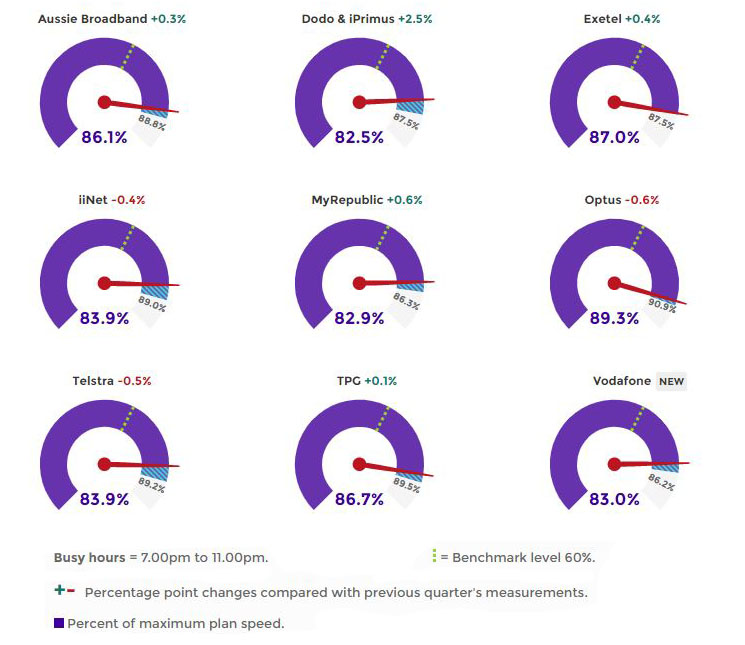The Australian Competition and Consumer Commission (ACCC) has released its latest report on NBN speeds across the country – and for the third quarter in a row, Optus has claimed the top spot.
The ninth Measuring Broadband Australia report is now live, and despite the increased traffic and data demands of the ongoing COVID-19 pandemic, NBN speeds appear to be holding steady. Compiling data from more than 254,500 speed tests performed during February 2020, the report assesses the average performance of nine leading NBN providers to provide an insight into just how the major telcos stack up speed-wise.
The ACCC’s findings measure the average speeds reached during peak traffic hours of between 7pm and 11pm each night. In order to accurately represent a provider’s performance, results are listed as a percentage of each connection’s maximum attainable speed, so you’ll find the NBN sellers below are ranked by percentage score rather than a specific speed in megabits per second (Mbps). The higher a provider’s overall download speed percentage, the more consistently fast its NBN plans were during the month-long testing period.
Fastest download speeds
For the third consecutive quarter, Optus has achieved the highest average peak hour download speed. The telco’s average busy hour download speed measured in at 89.3% of the maximum possible plan speed, pipping second-place provider Exetel’s 87.0% result.
In third place this quarter was former speed test darling TPG, who had previously dominated the ACCC’s rankings. TPG achieved an average of 86.7% of its maximum plan speed, just ahead of Aussie Broadband’s 86.1%.

Overall, NBN speeds improved all-round when compared to last quarter, with only iiNet, Optus, and Telstra showing slight declines in average evening performance. Dodo and iPrimus showed the biggest improvement, jumping up in average speed by 2.5% since the ACCC’s last report.
The full results are:
- Optus: 89.6%
- Exetel: 87.0%
- TPG: 86.7%
- Aussie Broadband: 86.1%
- iiNet: 83.9%
- Telstra: 83.9%
- Vodafone: 83.0%
- MyRepublic: 82.9%
- Dodo & iPrimus: 82.5%
The also marks the first appearance of Vodafone in the ACCC’s speed rankings. Despite being one of the ‘big three’ Australian mobile providers, Vodafone is still relatively new to the NBN market, but clocked in with a respectable 83.0% result.
If you’re interested in plans from the above providers, we’ve listed several below. The following table shows a selection of published unlimited Standard Plus Evening Speed (NBN 50) plans on Canstar Blue’s database, listed in order of their cost, from the lowest to highest and then by data allowance, largest to smallest. Use our comparison tool to see plans from a range of other providers. This is a selection of products with links to a referral partner.
Fastest upload speeds
Measuring NBN upload speeds during the 7pm-11pm evening period, Exetel offered the fastest on average, achieving 88.3% of the maximum speed available. In second place was TPG with 87.0%, followed by Optus with 86.8%.
The full results are:
- Exetel: 88.3%
- TPG: 87.0%
- Optus: 86.8%
- iiNet: 84.2%
- MyRepublic: 83.9%
- Aussie Broadband: 82.9%
- Telstra: 82.7%
- Dodo & iPrimus: 82.2%
ACCC: NBN speeds recovering from COVID-19 surge
According to the ACCC, average download NBN speeds dropped significantly during the initial transition to at-home isolation due to COVID-19. Speeds on the NBN 50 speed tier fell by 14%, while NBN 100 speeds dropped by 23%.
However, the network has since recovered from the increase in demand caused by millions of Australians working and studying from home. Thanks to NBN Co’s offer to allow providers to add 40% more capacity free of charge (plus additional measures, such as restricting the video quality of streaming services including Netflix and Stan), speeds have bounced back.
If you have noticed a drop in your NBN plan’s performance, there are several simple DIY steps to take to try and boost your average speed. You may also want to switch to a faster speed tier or different provider, or even consider a move to 4G or 5G mobile broadband if your NBN connection continues to underwhelm.
NBN 100: do you really need it?
One interesting takeaway from this quarter’s report is the average speeds achieved while streaming video. The ACCC looked at the speeds achieved by each provider’s NBN 50 and NBN 100 plans when streaming from Netflix and YouTube, and it seems we don’t need premium speeds for a great movie-viewing experience.
Looking at Netflix streaming, the ACCC found nearly all NBN 50 services tested are capable of supporting two simultaneous high-definition streams, even during busy hours. Almost all nine included providers are able to offer two concurrent HD streams on NBN 50 plans during both overall and peak traffic hours, with a similar result for single HD streams via YouTube.
To sum it up, if you’re on an NBN 100 primarily for streaming, you may be able to downgrade to a cheaper plan without affecting your Netflix performance.
“These results should prompt consumers to consider whether they actually need to pay extra for a higher-priced plan, or whether a cheaper plan could meet their needs,” said ACCC Chair Rod Sims.
“If consumers are still uncertain what plan they require, they can start on a lower speed plan and move up to a premium higher speed plan if and when they need to do so.”
Image: Vadym Pastukh / Shutterstock


Share this article